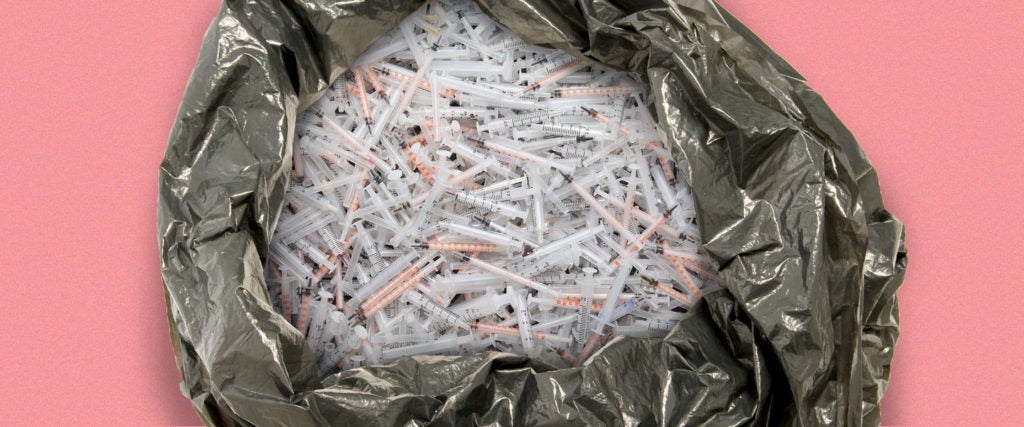Thirty million Americans have already been fully vaccinated against COVID, which means there’s only… 300 million more to go. Sounds daunting! And you know what else sounds daunting? Disposing of all those vaccine needles and syringes! When you extrapolate out this task to the entire human race, we’re talking at least 8 billion needles — enough of those sharp little things to wrap around the Earth [punches numbers in calculator, squints] 21 times! And considering that many of the current vaccinations require two shots per person, it’s actually going to be a hell of a lot more than that.
So, is there a plan for all of them? How do you dispose of used needles, anyway? Are we going to be living with them for thousands of years, or what? Where do billions of needles end up? Alongside Amesh Adalja, a senior scholar at the Johns Hopkins Center for Health Security, let’s inject some facts into this conundrum.
So how do you dispose of used needles?
No matter if it’s your county, your state or your doctor giving you the vaccine, there actually is a plan. They go into a “sharps” container, then a medical-waste company — there are several large ones nationwide, like Stericycle or MediWaste — picks them up and takes them away, just as they normally do for hospitals and clinics. These same companies handling the COVID medical waste all made contracts with the authorities doing the vaccinating.
And what do these medical waste companies do with them?
Probably less than you think! They’re generally not recycled — in fact, they end up buried in a landfill, sadly. But first they’re put through an autoclave, those box-like machines that sterilize and disinfect medical equipment using pressurized steam.
After that, medical waste is supposed to be put in special landfills, known somewhat hilariously as “sanitary landfills.” These are landfills that are sealed off not only from other landfills, but from anything else as well. They’re watertight, so that they don’t contaminate our public water (or get blown away, or eaten by wildlife, like seagulls at a garbage dump).
There was a time when needles used to be incinerated, but that’s terrible for air quality, as it creates carbon monoxide and a lot of ash. Lots of states don’t actually allow it, although one exception is a company called OnSite Waste Technologies, which does something unique: They’re able to melt down needles into a small brick.
Yeah, but how are all these companies gonna handle 300 million more?
It sounds like a lot, doesn’t it? But Adalja says it really isn’t. “You have to remember that there are billions of injections given every year,” he explains. “Even though it seems like it’s a humongous amount of vaccines being given, if you think about how many shots are given for all the childhood diseases, flu vaccines and all of the insulin syringes, the majority of our needles are still going to come from outside COVID,” he says.
Indeed, a look at CDC data shows that roughly 90 percent of kids get vaccinated for common vaccines. There are 24.5 million kids under age six in the U.S., which means that’s at least 22 million vaccines given just on tiny children every year (usually double that, since most get more than one). Then think about how many millions of IVs are given at hospitals and how much blood is drawn at outpatient clinics. Plus, the fact that 7.4 million diabetic Americans use insulin.
Still, this is a lot of extra needles!
Regardless, our expert doesn’t seem worried. “I don’t think there’s a major concern about the capacity to deal with the increase,” Adalja says. “In general it will just sort of be absorbed by the system that already exists.”
Who’s paying for all of this disposal?
A quick look at my local government’s contract with a waste disposal company suggests the Federal Emergency Management Agency is on the hook for pretty much all of it — and, sure enough, they are. Which is a long way of saying that federal taxpayers are paying for it all.
Can’t needles just be recycled or something?
Nope. Apparently the risk of disease transmission is too high, and nobody wants to deal with them. There’s just no way to safely handle a kajillion extremely sharp little things that are designed specifically to puncture skin.
So these needles and all the other COVID waste generated in the last 12 months is gonna outlive us all, huh?
Yep, although they’ll be residing underground. Sad but true. At least future generations won’t be accidentally stepping on them or whatever.
And is it pretty much the same everywhere?
Adalja says most of the developed world takes pretty good care of needle disposal, and he’s not aware of any places that have had issues with needle littering. But! Let’s not kid ourselves. The World Health Organization estimates there are 16 billion injections given worldwide each year, and it’s easy enough to imagine that some places don’t have strict regulations on what happens to the leftovers. The best we can do is hope everyone has the good sense not to do anything too stupid with them.
But on the bright side? At least needles are something we know how to dispose of, and we do it safely. Maybe it’s all the disposable masks, latex gloves and all that other stuff we should be worried about.

